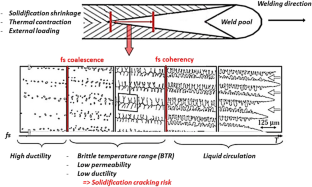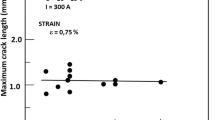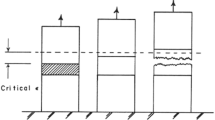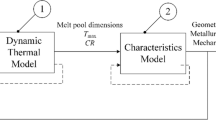Abstract
Solidification cracking is a weld defect common to certain susceptible alloys rendering many of them unweldable. It forms and grows continuously behind a moving weld pool within the two-phase mushy zone and involves a complex interaction between thermal, metallurgical, and mechanical factors. Research has demonstrated the ability to minimize solidification cracking occurrence by using appropriate welding parameters. Despite decade’s long efforts to investigate weld solidification cracking, there remains a lack of understanding regarding the particular effect of travel speed. While the use of the fastest welding speed is usually recommended, this rule has not always been confirmed on site. Varying welding speed has many consequences both on stress cells surrounding the weld pool, grain structure, and mushy zone extent. Experimental data and models are compiled to highlight the importance of welding speed on solidification cracking. This review is partitioned into three parts: part I focuses on the effects of welding speed on weld metal characteristics, part II reviews the data of the literature to discuss the importance of selecting properly the metrics, and part III details the different methods to model the effect of welding speed on solidification cracking occurrence.
















Similar content being viewed by others
Abbreviations
- h :
-
Plate thickness
- s :
-
Travel speed
- t :
-
Time
- x :
-
Direction of heat source displacement
- BTR:
-
Brittle temperature range
- CET:
-
Columnar-to-equiaxed transition
- CSZ:
-
Crack-susceptible zone
- G :
-
Temperature gradient
- H :
-
Heat input
- I :
-
Welding current
- K :
-
Thermal conductivity
- LHC:
-
Linear heat content
- Q :
-
Welding power
- R :
-
Solidification growth rate
- R i :
-
Radius of weld cross section
- SCTR:
-
Solidification cracking temperature range
- T :
-
Temperature
- U :
-
Welding voltage
- α :
-
Thermal diffusivity
- ε :
-
Strain
- \( \dot{\varepsilon} \) :
-
Strain rate
- ξ :
-
Traveling coordinates
- η :
-
Welding efficiency
References
Nguyen TC, Weckman DC, Johnson DA, Kerr HW (2006) High speed fusion weld bead defects. Sci Technol Weld Join 11:618–633. https://doi.org/10.1179/174329306X128464
Nguyen TC, Weckman DC, Johnson DA, Kerr HW (2005) The humping phenomenon during high speed gas metal arc welding. Sci Technol Weld Join 10:447–459. https://doi.org/10.1179/174329305X44134
Campbell J (2003) Castings. Elsvier Science Ltd
Niel A, Deschaux-Beaume F, Bordreuil C, Fras G, Drezet JM (2011) Hot tearing test for TIG welding of aluminum alloys: application of a stress parallel to the fusion line. In Hot cracking phenomena in welds III (pp. 43–58). Springer, Heidelberg
Pumphrey WI, Lyons JV (1948) Cracking during the casting and welding of the more common binary aluminum alloys. JIM. 74:439–455
Chen S, Guillemot G, Gandin C (2016) Three-dimensional cellular automaton finite element modeling of solidification grain structures for arc-welding processes. Acta Mater 115:448–467. https://doi.org/10.1016/j.actamat.2016.05.011
Matsuda F, Nakagawa H, Sorada K (1982) Dynamic observation of solidification and solidifìcation cracking during welding with optical microscopy (I). Trans JWRI:67–77
Savage WF, Aronson AH (1966) Preferred orientation in the weld fusion zone. Weld J 45:85s–89s
Davies GJ, Garland JG (1975) Solidification structures and properties of fusion welds. Int Metall Rev 20:83–108
Zacharia T (1994) Dynamic stresses in weld metal hot cracking. Weld J:164–172
Chen S, Ye X, Tsang DKL, Jiang L, Yu K, Li C, Li Z (2019) Welding solidification cracking susceptibility and behavior of a Ni-28W-6Cr alloy. J Mater Sci Technol 35:29–35. https://doi.org/10.1016/j.jmst.2018.09.013
Alexandrov BT, Lippold JC (2005) Relationship between the solidification temperature range and weld solidification cracking susceptibility of stainless steels and Ni-base alloys. Weld World Doc IX-21:1–12
Lippold JC (2005) Recent developments in weldability testing. Hot Crack Phenom Welds:271–290. https://doi.org/10.1007/3-540-27460-X_14
Hunziker O, Dye D, Reed RC (2000) On the formation of a centreline grain boundary during fusion welding. Acta Mater 48:4191–4201
DuPont JN, Robino CV, Marder AR (1999) Modelling mushy zones in welds of multicomponent alloys: implications for solidification cracking. Sci Technol Weld Join 4:1–14. https://doi.org/10.1179/stw.1999.4.1.1
Schempp P, Cross CE, Pittner A, Oder G, Neumann RS, Rooch H, Dorfel I, Osterle W, Rethmeier M (2014) Solidification of GTA aluminum weld metal: part I–grain morphology dependent upon alloy composition and grain refiner content. Weld J 93:53s–59s
Lundin CD, Chou CPD (1983) Hot cracking susceptibility of austenitic stainless steel weld metals. Weld Res Counc 289:1–79 http://www.aws.org/wj/supplement/WJ_1982_03_s82.pdf
Hagenlocher C, Weller D, Weber R, Graf T (2019) Analytical description of the influence of the welding parameters on the hot cracking susceptibility of laser beam welds in aluminum alloys. Metall Mater Trans A 50:5174–5180. https://doi.org/10.1007/s11661-019-05430-7
Coniglio N, Cross CE (2008) Weld parameter and minor element effects on solidification crack initiation in aluminium. In: Hot crack. Phenom. Welds II
Dvornak MJ, Frost RH, Olson L (1988) The weldability and grain refinement of AI-2.2Li-2.7Cu. Weld J 68:327s–335s
Mousavi MG, Cross CE, Grong Ø (2015) Effect of scandium and titanium–boron on grain refinement and hot cracking of aluminium alloy 7108. Sci Technol Weld Join 4:381–388. https://doi.org/10.1179/136217199101538030
Marshall WKB (1945) Welding aluminum-magnesium alloys. Trans Inst Weld:53–57
Arata Y, Matsuda F, Nakata K, Shinozaki K (1977) Solidification crack susceptibility of aluminum alloy weld metals (report II). Trans JWRI 6:91–104
Hagenlocher C, Weller D, Weber R, Graf T (2018) Reduction of the hot cracking susceptibility of laser beam welds in AlMgSi alloys by increasing the number of grain boundaries. Sci Technol Weld Join:1–7. https://doi.org/10.1080/13621718.2018.1534775
Drezet JM, Lima MSF, Wagnière JD, Rappaz M, Kurz W (2008) Crack-free aluminium alloy welds using a twin laser process. Weld World 52:87–94
Lin S, Aliravci C, Pekguleryuz MO (2007) Hot-tear susceptibility of aluminum wrought alloys and the effect of grain refining. Metall Mater Trans A Phys Metall Mater Sci 38:1056–1068. https://doi.org/10.1007/s11661-007-9132-7
Schempp P (2013) Grain refinement in aluminium GTA welds. Technische Universitat, Berlin
Coniglio N, Cross CE (2009) Mechanisms for solidification crack initiation and growth in aluminum welding. Metall Mater Trans A 40:2718–2728. https://doi.org/10.1007/s11661-009-9964-4
Coniglio N, Cross CE (2013) Initiation and growth mechanisms for weld solidification cracking. Int Mater Rev 58:375–397. https://doi.org/10.1179/1743280413Y.0000000020
Coniglio N (2008). Aluminum alloy weldability: identification of weld solidification cracking mechanisms through novel experimental technique and model development. Otto-von-Guericke-Universität Madgeburg. BAM, Berlin
Rajani HRZ, Phillion AB (2018) 3D multi-scale multi-physics modelling of hot cracking in welding. Mater Des 144:45–54. https://doi.org/10.1016/j.matdes.2018.02.007
Coniglio N, Cross CE (2014) Coherency and grain size effects on solidification crack growth in aluminum welds. Mater Test Join Appl 56:583–590
Braccini M, Martin C, Suery M (2000) Relation between mushy zone rheology and hot tearing phenomena in Al-Cu alloys. Model Cast Weld Adv Solidif Process IX:18–24 papers3://publication/uuid/B3582EAE-4EBC-48C2-8D43-F45001DFB1A4
Coniglio N, Cross CE (2008) Weld parameter and minor element effects on solidification crack initiation in aluminium. In Hot cracking phenomena in welds II. Springer, Heidelberg, pp 277–310
Ramanaiah N, Rao KS, Guha B, Rao KP (2005) Effect of modified AA4043 filler on partially melted zone cracking of Al-alloy gas tungsten arc welds. Sci Technol 10:591–596. https://doi.org/10.1179/174329305X57482
Madhusudhan Reddy G, Mukhopadhyay AK, Sambasiva Rao A (2005) Influence of scandium on weldability of 7010 aluminium alloy. Sci Technol Weld Join 10:432–441. https://doi.org/10.1179/174329305X29456
Dudas JH, Collins FR (1966) Preventing weld cracks in high-strength aluminum alloys. Weld J 45:241s–249s
Ravi KR, Manivannan S, Phanikumar G, Murty BS, Sundarraj S (2011) Influence of Mg on grain refinement of near eutectic Al-Si alloys. Metall Mater Trans A Phys Metall Mater Sci 42:2028–2039. https://doi.org/10.1007/s11661-010-0600-0
Mousavi MG, Hermans MJM, den Ouden G (2001) Effect of electromagnetic stirring on hot cracking susceptibility of aluminum alloy welds. In: Proceedings of JOM Int Conf pp 176–183
Biradar NS, Raman R (2012) Investigation of hot cracking behavior in transverse mechanically arc oscillated autogenous AA2014 T6 TIG welds. Met Mater Trans A 43A:3179–3191. https://doi.org/10.1007/s11661-012-1126-4
Arata Y, Matsuda F, Nakagawa H, Katayama S, Ogata S (1977) Solidification crack susceptibility in weld metals of fully austenitic stainless steels ( report III). Trans JWRI 6:37–46
Wei Y, Dong Z, Liu R, Dong Z (2006) Modeling the Trans-Varestraint test with finite element method. Comput Mater Sci 35:84–91. https://doi.org/10.1016/j.commatsci.2005.03.007
Nakata K, Matsuda F (1995) Evaluations of ductility characteristics and cracking susceptibility of Al alloys during welding. Trans JWRI 24:83–94
Matsuda F, Nakagawa H, Kohmoto H, Honda Y, Matsubara Y (1983) Quantitative evaluation of solidification brittleness of weld metal during solidification by in-situ observation and measurement (report II). Trans JWRI:73–80
Senda T, Matsuda T, Takano F, Watanabe G, Kobayashi K, Matsuzaka T (1971) Fundamental investigations on solidification crack susceptibility for weld metals with trans-varestraint test. Trans JWS 2:1–22. https://doi.org/10.2207/qjjws1943.41.709
Nelson TW, Lippold JC, Lin W, Baeslack WA III (1997) Evaluation of the circular patch test for assessing weld solidification cracking, part I—development of a test method. Weld J:110–119
Savage WF, Lundin CD (1965) The Varestraint test. Weld J 44:433s–442s
Bailey N, Jones SB (1978) The solidification cracking of ferritic steel during submerged arc welding. Weld J 57:217s–231s
WA Baeslack III DD, Harwig JC, Lippold (1990) Weldability testing of Al-Mg-Si-alloys. Research report MR9007, EWI
Robino CV, Reece M, Knorovsky GA, DuPont JN, Feng Z (2005) Prediction of maximum crack length in longitudinal Varestraint testing. ASM Proc Int Conf Trends Weld Res 2005:313–318
Robino CV, Reece M, Knorovsky GA, DuPont JN, Feng Z (2005) Prediction of maximum crack length in longitudinal varestraint testing. ASM Proc Int Conf Trends Weld Res:313–318 papers3://publication/uuid/33CA970E-E705-4ED5-9186-31FE74E62377
Statharas D, Atkinson H, Thornton ROB (2019) Getting the strain under control: Trans-Varestraint tests for hot cracking susceptibility. Metall Mater Trans A 50:1748–1762. https://doi.org/10.1007/s11661-019-05140-0
Matsuda F, Nakata K, Harada S (1980) Moving characteristics of weld edges during solidification in relation to solidification cracking in GTA weld of aluminum alloy thin sheet. Trans JWRI 9:83–93
Arata Y, Matsuda F, Nakata K, Katayama S (1977) Solidification crack susceptibility in weld metals of fully austenitic steels (report II)–effect of ferrite, P, S, C, Si, and Mn on ductility properties of solidification brittleness. Trans JWRI 6:105–117
Feng Z, David A, Zacharia T, Tsai CL (1997) Quantification of thermomechanical conditions for weld solidification cracking. Sci Technol Weld Join 2:11–19. https://doi.org/10.1179/stw.1997.2.1.11
Arata Y, Matsuda F, Nakata K, Shinozaki K (1977) Solidification crack susceptibility of aluminum alloy weld metals (report II)-effect of straining rate on cracking threshold in weld metal during solidification. Trans JWRI 6:91–104
Matsuda F, Nakagawa H, Nakata K, Okada H (1979) The VDR cracking test for solidification crack susceptibility on weld metals and its application to aluminum alloys. Trans JWRI 8:85–95
Tamura H, Kato N, Ochiai S, Katagiri Y (1977) Cracking study of aluminum alloys by the variable tensile strain hot cracking test. Trans JWS 8:16–22
Morgan-Warren EJ, Jordan MF (1976) Effect of travel speed on solidification cracking in autogenous tungsten inert gas arc welding of low-alloy steel sheet. Met Technol:29–40. https://doi.org/10.1179/030716976803391421
Zacharia T, Eraslan AH, Aidun DK, David SA (1989) Three-dimensional transient model for arc welding process. Metall Trans B 20B:645–659
Fachinotti VD, Cardona A (2008) Semi-analytical solution of the thermal field induced by a moving double-ellipsoidal welding heat source in a semi-infinite body. Mec Comput XXVII:1519–1530 e:%5CBIBLIO%5CArticles%5CSemi-analyt-solution-thermal-field-moving-welding-heat_Fachinotti_2008.pdf
Goldak J, Chakravarti A, Bibby M (1984) A new finite element model for welding heat sources. Metall Trans B 15:299–305. https://doi.org/10.1007/BF02667333
Johnson BYL (1973) Formation of plastic strains during welding of aluminum alloys. Weld J 52:298s–305s
Feng Z (1994) A computational analysis of thermal and mechanical conditions for weld metal solidification cracking. Weld World 33:340–347
Mandal NR, Sundar CVN (1997) Analysis of welding shrinkage. Weld J:233–238
Chihoski RA (1972) The character of stress fields around a weld arc moving on aluminum sheet. Weld J 168:9s–18s
Feng Z, Zacharia T, David S (1996) On the thermomechanical conditions for weld metal solidification cracking. In: Math. Model. Weld Phenom. 3. Eds: Cerjak H, H.K.D.H. Bhadeshia HKDH. The Institute of Materials, London, pp 114–148
Argawa G, Gao H, Armithalingam M, Hermans M (2018) Study of solidification cracking susceptibility during laser welding in an advanced high strength automotive steel. Metals (Basel) 8:1–15. https://doi.org/10.3390/met8090673
Cross CE, Bollinghaus T (2006) The effect of restraint on weld solidification cracking in aluminum. Weld World 50:51–54
Sterjovski Z, Bayley C, Donato J, Lane N, Lang D (2014) Weld-end solidification cracking in pulsed-tandem gas metal arc welding of naval steels. Weld J 93:145–152
Author information
Authors and Affiliations
Corresponding author
Additional information
Publisher’s note
Springer Nature remains neutral with regard to jurisdictional claims in published maps and institutional affiliations.
Rights and permissions
About this article
Cite this article
Coniglio, N., Cross, C.E. Effect of weld travel speed on solidification cracking behavior. Part 1: weld metal characteristics. Int J Adv Manuf Technol 107, 5011–5023 (2020). https://doi.org/10.1007/s00170-020-05231-y
Published:
Issue Date:
DOI: https://doi.org/10.1007/s00170-020-05231-y




